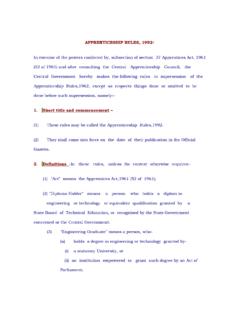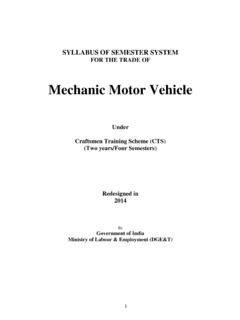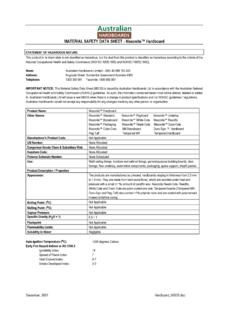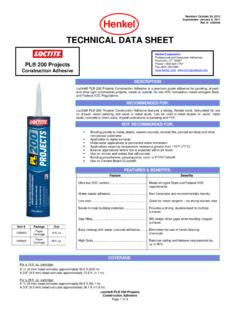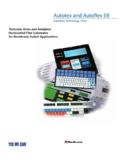Transcription of Mechanic Tractor - DGE&T
1 1 SYLLABUS OF SEMESTER SYSTEM FOR THE TRADE OF Mechanic Tractor Under Craftsmen Training Scheme (CTS) (One Year/Two Semesters) Redesigned in 2014 By Government of India Ministry of Labour & Employment (DGE&T) 2 GENERAL INFORMATION 1. Name of the Trade : Mechanic Tractor 2. & NOS Code No. : 3. Duration of Craftsmen Training : 1 Year (Two Semester having duration of six months each) 4. Power Norms : KW 5. Space Norms : 210 Sq. mtr. (Including Parking room) 6. Entry Qualification : Passed 10th class examination with Maths and Science 7. Unit strength : 16 + 30% super Numeric 8. Instructors Qualification : a) Degree in Agriculture Engineering / Automobile/ Mechanical Engg. (with specialization in Automobile) from recognized university with one year experience in Tractor industry and should possess valid LMV driving license. OR Diploma in Agriculture Engineering Agriculture Engineering / Automobile/ Mechanical Engg.
2 (with specialization in Automobile) from a recognized board of Technical education with two year in Tractor industry and should possess valid LMV driving license.. OR 10th Passed + NTC/NAC in the Trade of Mechanic Tractor ) with 3 years post qualification experience in the relevant field and and should possess valid LMV driving license. and b) With National Crafts Instructor Certificate . * Note: 1) At least one Instructor Degree/Diploma inAgriculture Engineering / Automobile/ Mechanical Engg. (with specialization in Automobile) when applied for 02 units. 2) Instructor Qualification for WCS & , as per the Training Manual 3 9. For Employability Skills One Contract/Part Time/Guest Faculty for Generic Module . i) MBA/ BBA with two years experience OR Graduate in Sociology / Social Welfare / Economics with Two years experience OR Graduate / Diploma with Two years experience and trained in Employability Skills from DGET institutes AND Must have studied English / Communication Skills and Basic Computer at 12th / Diploma level and above OR Existing Social Study Instructors duly trained in Employability Skills from DGET institutes Distribution of training on Hourly basis: Total hours /week Trade practical Trade theory Work shop Cal.
3 &Sc. Engg. Drawing Employability skills Extra curricular activity 42 Hours 27 Hours 5 Hours 3 Hours 3 Hours 2 Hours 2 Hours 4 COURSE INFORMATION ( Tractor Mechanic ) : An intensive industrial survey was made to ascertain the requirements of skill-gap in the automobile sector, a scientifically designed survey covering labour-market survey web-survey was conducted. Based on the data obtained the skills are identified and accordingly the syllabus has been drafted. Subsequently the Trade expert committed reviewed. 2. Terminal Competencies/Deliverables : After successful completion of the above course, the trainee shall be able to perform the following skills with proper sequence. Maintains, services, repairs or overhauls different farm equipment such as tractors , Power tillers, Sprayers, Drillers, etc. Examines and drives vehicle on road or runs engine in stationary position to diagnose troubles and defects.
4 Dismantles part or complete engine or unit according to nature of defects. Repairs or replaces defective parts, reassembles them with prescribed settings, clearances, timings and adjustments by further tooling as necessary and ensures accuracy of fit. Installs assembled or repaired engine securely in position on vehicle controls and other accessories. Starts engine and observes performance for any unusual noise and knocks. Adjusts carburettor, fuel pump (Carburettor for petrol engine and fuel pump for diesel engine), sets clearance between tappets and valves, tunes engine, adjusts brakes, makes electrical connections and performs other tasks to ensure stipulated performance. May repair and overhaul electric motors, fuel pump, carburettor etc. of engine. May weld, braze or solder parts. 5 3. Employment opportunities: On successful completion of the course the candidates can either get employed, or become a self-employed Entrepreneur in any one of the following fields.
5 A) Wage Employment 1. Tractor Service Mechanic 2. Auto Fitter in Tractor Manufacturing Concern in Assembly Shop or Test Shop 3. Dealers service Mechanic 4. Driver/ Tractor Operator 5. Spare Parts Sales Assistant / Manufacturers' Representative 6. Laboratory Assistant b) Self Employment 1. Tractor Service Mechanic 3. Tractor Operator 4. Spare Parts Salesman 5. Spare Parts Dealer 4. Further learning pathways: On successful completion of the course trainee can get themselves enrolled in Apprenticeship training in reputed Industrial organisation. The qualified candidates have scope for lateral entry into the Diploma courses offered by some of the State Governments The qualified candidates can also get themselves upgraded by taking up the Second Semester at his own convenience in the CTS scheme, since the first semester is common to the following trades. Craftsman Training Scheme 1.
6 Mechanic Motor Vehicle - 2 Years ( 4 Sem) 2. Mechanic Diesel 1 Year ( 2 Sem) 3. Mechanic Motor Cycle - 1 Year ( 2 Sem) 4. Mechanic Auto Electrical and Electronics - 1 Year ( 2 Sem) 5. Mechanic Agricultural Machinery - 2 Years ( 4 Sem) 6. Mechanic Tractor - 1 Year ( 2 Sem) 7. Pump Operator cum Mechanic - 1 Year ( 2 Sem) 6 Syllabus for the trade of Mechanic Tractor First Semester (Semester code No. ) Duration: Six Months. Syllabus for Trade practical and Trade Theory Week No. Trade Practical (27 Hrs/week) Trade Theory (5 Hrs/week) 1 Familiarisation with institute, Job opportunities in the automobile sector, Machinery used in Trade. Types of work done by the students in the shop floor.
7 Admission & introduction to the trade: Introduction to the Course duration, course content, study of the syllabus. General rule pertaining to the Institute, facilities available Hostel, Recreation, Medical and Library working hours and time table 2 Practical related to Safety and Health, Importance of maintenance and cleanliness of Workshop. Interaction with health centre and fire service station to provide demo on First aid and Fire safety, Use of fire extinguishers. Demonstration on safe handling and Periodic testing of lifting equipment, and Safety disposal of Used engine oil. Energy saving Tips of ITI electricity Usage Occupational Safety & Health Importance of Safety and general Precautions to be observed in the shop. Basic first aid, safety signs - for Danger, Warning, caution & personal safety message. Safe handling of Fuel Spillage, Fire extinguishers used for different types of fire.
8 Safe disposal of toxic dust, safe handling and Periodic testing of lifting equipment, Authorization of Moving & road testing vehicles. Energy conservation-Definition, Energy Conservation Opportunities (ECOs)-Minor ECos and Medium ECOs, Major ECOs), Safety disposal of Used engine oil, Electrical safety tips. 3-5 Practice using all marking aids, like steel rule with spring calipers, dividers, scriber, punches, Chisel etc., Layout a work piece- for line, circle, arcs and circles. Practice to measure a wheel base of a vehicle with measuring tape. Practice to measure valve spring tension using spring tension tester Practice to remove wheel lug nuts with use of an air impact wrench Practice on General workshop tools & power tools. Hand & Power Tools:- Marking scheme, Marking material-chalk, Prussian blue. Cleaning tools- Scraper, wire brush, Emery paper, Description, care and use of Surface plates, steel rule, measuring tape, try square.
9 Calipers-inside and outside. Dividers, surface gauges, scriber, punches-prick punch, center punch, pin punch, hollow punch, number and letter punch. Chisel-flat, cross-cut. Hammer- ball pein, lump, mallet. Screw drivers-blade screwdriver, Phillips screw driver, Ratchet screwdriver. Allen key, bench vice & C-clamps, Spanners- ring spanner, open end spanner & the combination spanner, universal adjustable open end spanner. Sockets & accessories, Pliers - Combination pliers, multi grip, long nose, flat-nose, Nippers or pincer pliers, Side cutters, 7 Tin snips, Circlip pliers, external circlips pliers. Air impact wrench, air ratchet, wrenches- Torque wrenches, pipe wrenches, car jet washers Pipe flaring & cutting tool, pullers-Gear and bearing. 6&7 Measuring practice on Cam height, Camshaft Journal dia, crankshaft journal dia, Valve stem dia, piston diameter, and piston pin dia with outside Micrometers.
10 Measuring practice on the height of the rotor of an oil pump from the surface of the housing or any other auto component measurement with depth micrometer. Measuring practice on valve spring free length. Measuring practice on cylinder bore, Connecting rod bore, inside diameter (ID) of a camshaft bearing with Telescope gauges. Measuring practice on cylinder bore for taper and out-of-round with Dial bore gauges. Measuring practice to measure wear on crankshaft end play, crankshaft run out, and valve guide with dial indicator. Measuring practice to check the flatness of the cylinder head is warped or twisted with straightedge is used with a feeler gauge. Measuring practice to check the end gap of a piston ring, piston-to-cylinder wall clearance with feeler gauge. Practice to check engine manifold vacuum with vacuum gauge.
